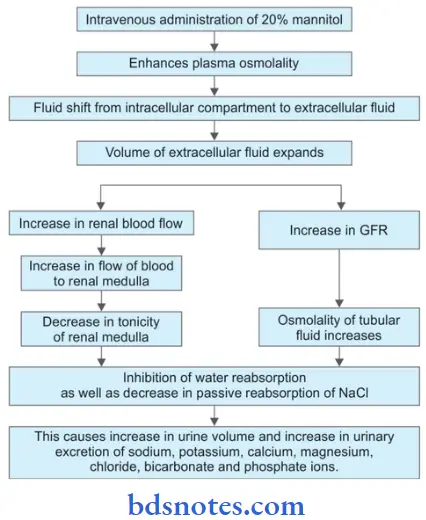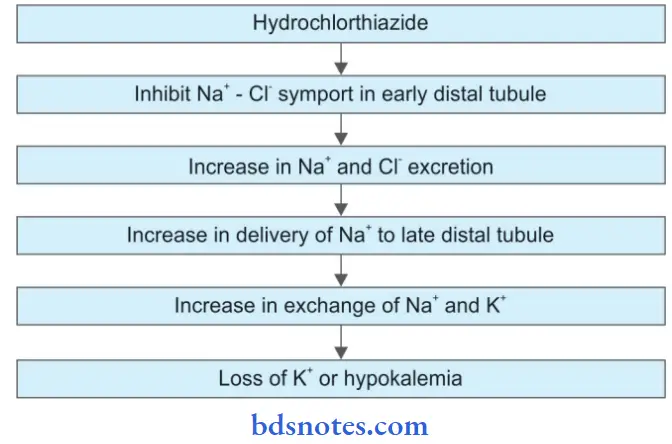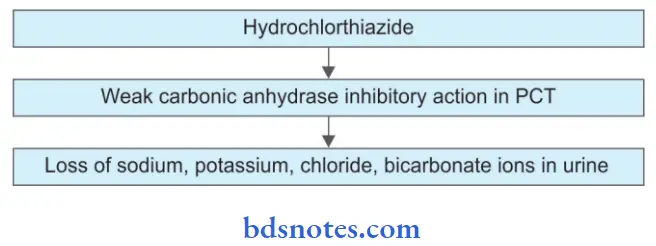Drugs Acting On Kidney
Question 1. Write On Furosemide (Action And Uses).
Answer:
Furosemide is a drug of high efficacy.
Furosemide Actions
- Furosemide inhibits the reabsorption of Na+ in interstitial tissue by inhibiting the Na+/K+/2Cl–cotransporter present on the luminal membrane of the thick ascending limb of the loop of Henle.
So Na+ and Cl– are retained in the lumen and get excreted via urine. - The tubular fluid which reaches the distal convoluted tubule consists of a large number of sodium ions, so here more sodium ion exchanges with potassium ions which leads to a loss of potassium ions.
- Furosemide has weak carbonic anhydrase inhibitory action and increases bicarbonate ion excretion.
- Furosemide increases calcium ion as well as magnesium ion excretion.
Read And Learn More: Pharmacology Question And Answers
Furosemide Therapeutic Uses
- Furosemide is indicated in the initial stages of both renal as well as cardiac edema. It is also used in the treatment of hepatic edema.
- IV furosemide with isotonic saline is used to treat hypercalcemia.
- IV furosemide is the choice of drug to be used in acute pulmonary edema.
- It is indicated in hypertension associated with congestive cardiac failure or renal failure.
- It is used in hypertensive emergencies.
- Furosemide is given at the time of blood transfusion for preventing volume overload.
- It is also used in prophylaxis of acute renal failure.
Question 2. Give A Description Of The Adverse Effects Of Furosemide.
Answer:
- At high doses, it shows mild alkalosis.
- Acute change in renal and systemic hemodynamics
- It raises blood uric levels and causes hyperuricemia.
- It also leads to hyperglycemia and hyperlipidemia
- It causes hypokalemia.
- It causes hyponatremia, i.e. depletion of sodium from the body.
- It decreases carbohydrate tolerance.
- Because of sodium loss at higher doses, it leads to a change in electrolyte composition of endolymph which can be responsible for transient or permanent deafness.
Question 3. Comment On Furosemide In Edema.
Or
Explain Why Furosemide Is Used In The Treatment Of Acute Pulmonary Edema.
Answer:

Question 4. Describe Osmotic Diuretics.
Answer:
Osmotic diuretics are mannitol, glycerol and isosorbide. Osmotic diuretics retain water in descending limb of the loop of Henle and the proximal convoluted tubule.
These drugs should be given IV as they are not absorbed orally.

Osmotic Diuretics Therapeutic Uses
- These drugs reduce intracranial tension after a head injury or due to a tumor.
- Osmotic diuretics reduce elevated intraocular pressure in acute congestive glaucoma.
- Mannitol in shock, in cardiovascular surgery, etc. prevents acute renal shutdown.
- Mannitol after dialysis maintains osmolality of extracellular fluid.
Osmotic Diuretics Adverse Effects
- If more quantity of IV mannitol is used, it leads to the expansion of extracellular fluid volume which causes pulmonary edema.
- Osmotic diuretics cause nausea, headache, and vomiting.
- Glycerol may lead to hyperglycemia.
Question 5. Comment On Hydrochlorthiazide.
Or
Write A Short Note On Hydrochlorothiazide.
Answer:
Hydrochlorthiazide is a short acting thiazide.
- It acts on a cortical diluting segment or early distal tubule.
Hydrochlorothiazide Mechanism of Action
First Action

Second Action

Hydrochlorthiazide Therapeutic Uses
- Edema: It decreases the edema which is caused due to congestive cardiac failure.
- Hypertension: It is used in the treatment of essential hypertension.
- Hypercalciuria: As it decreases the secretion of calcium in urine it is used to treat calcium nephrolithiasis.
- Diabetes insipidus: It reduces plasma volume and GFR in diabetes insipidus.
Hydrochlorthiazide Adverse Effects
- It can lead to hypokalemia, hyponatremia, metabolic alkalosis, hypomagnesemia and hypercalcemia.
- It leads to metabolic disturbances such as hyperglycemia, hyperlipidemia, and hyperuricemia.
- They can lead to impotence.
- It can cause photosensitivity, headache, nausea, vomiting, paresthesia, etc.
Question 6. Enumerate The Contraindication Of Furosemide.
Answer:
Furosemide Contraindications
The drug is contraindicated in
- Pronounced hyponatremia or hypovolemia
- Anuria
- In heart failure without fluid retention
- In patients who are allergic to sulphonamides.
Question 7. Write Contraindications Of Thiazide Diuretics.
Answer:
Thiazide Diuretics Contraindications
- They cause hypokalemia and lead to digitalis toxicity.
- They cause an increase in the incidence of ventricular tachycardia due to quinidine and other antiarrhythmics.
- They reduce sulphonylurea action.
Question 8. Describe High Ceiling Diuretics.
Or
Write Short Note On High Ceiling Diuretics.
Or
Enumerate Therapeutic Uses Of Loop Diuretics.
Or
Describe Briefly Mechanism Of Action, Therapeutic Uses Of Furosemide.
Answer:
High Ceiling Diuretics
- They are also known as loop diuretics.
- High-ceiling diuretics are the inhibitors of Na+–K+–2Cl– Co-transport.
- The high ceiling diuretics are furosemide, bumetanide, torasemide.
High Ceiling Diuretics Furosemide
- The development of this orally and rapidly acting highly efficient diuretic was a breakthrough.
- Its maximal natriuretic effect is much greater than that of other classes.
- The diuretic response goes on increasing with increasing dose, up to 10 L of urine may be produced in a day.
- It is active even in patients with relatively severe renal failure.
- The onset of action is prompt and short duration (3–6 hours).
High Ceiling Diuretics Mechanism of Action
- Furosemide inhibits the reabsorption of Na+ in interstitial tissue by inhibiting the Na+/K+/2Cl– cotransporter present on the luminal membrane of the thick ascending limb of the loop of Henle.
So Na+ and Cl– are retained in the lumen and get excreted via urine. - The tubular fluid which reaches the distal convoluted tubule consists of a large number of sodium ions, so here more sodium ion exchanges with potassium ions which lead to the loss of potassium ions.
- Furosemide has weak carbonic anhydrase inhibitory action and increases bicarbonate ion excretion.
- Furosemide increases calcium ion as well as magnesium ion excretion.
High Ceiling Diuretics Bumetanide
- It is 40 times more potent than furosemide.
- It induces rapid diuresis and is very effective in pulmonary edema.
- Hyperuricemia, potassium loss, glucose intolerance, and ototoxicity are less than furosemide.
High Ceiling Diuretics Torasemide
- It is three times more potent than furosemide.
- Oral absorption is more rapid and more complete.
- It is used in edema and hypertension.
High Ceiling Diuretics Uses
Loop diuretics are also known as high-ceiling diuretics.
- Edema: Diuretics are used irrespective of the etiology of edema—cardiac, hepatic, or renal. High-ceiling diuretics are preferred in CHF for rapid mobilization of edema fluid.
- Thiazides may be used for maintenance, but often prove ineffective and high-ceiling drugs are called in for nephrotic and other forms of resistant edema, the high ceiling diuretics are the drugs of choice.
- ln chronic renal failure massive doses have to be used, but they continue to be effective while thiazides just do not produce any action. ln impending acute renal failure, loop diuretics may decrease the need for dialysis.
- Acute pulmonary edema: Intravenous administration of furosemide or its congeners produces prompt relief. This is due to the vasodilator action that precedes the saluretic action. Subsequently, a decrease in blood volume and venous return is responsible for the improvement.
- Cerebral edema: Though osmotic diuretics are primarily used, furosemide may be combined to improve efficacy.
- Hypertension: High-ceiling diuretics are indicated only in the presence of renal insufficiency.
- CHF, in resistant cases or hypertensive emergencies; otherwise thiazides are preferred.
- Along with blood transfusion in severe anemia, to prevent vascular overload.
- Hypercalcemia and renal calcium stones: Because furosemide and its congeners increase calcium excretion and urine flow, they may help to reduce serum calcium levels. Excess salt that is lost must be replaced. Forced diuresis with saline and furosemide infusion is no longer recommended to treat poisonings.
High Ceiling Diuretics Adverse Effects
- Hypokalemia
- Acute saline depletion
- GIT disturbances, i.e. nausea, vomiting, and diarrhea
- CNS disturbances, i.e. headache, giddiness, weakness, paresthesia
- Hearing loss
- Allergic manifestation, i.e. rashes and photosensitivity
- Hypercalcemia
- Magnesium depletion.
High Ceiling Diuretics Drug Interaction
- High-ceiling diuretics potentiate antihypertensives.
- High-ceiling diuretics and aminoglycoside are both ototoxic and nephrotoxic so should not be given together.
- Indomethacin and other NSAIDs diminish the action of high-ceiling diuretics.
- Probenecid competitively inhibits tubular secretion for furosemide.
Question 9. Write Briefl On Potassium Sparing Diuretic.
Answer:
The potassium-sparing diuretics are weak or adjunctive diuretics.
The Potassium Sparing Diuretics
- Aldosterone antagonist: Spironolactone
- Inhibitors of renal epithelial sodium channel: Triamterene, amiloride
Potassium Sparing Diuretic Spironolactone
Mechanism of Action
- Spironolactone, a competitive antagonist of the mineralocorticoid aldosterone, interferes with aldosterone-mediated Na+–K+ exchange, increasing Na+ loss at the distal tubular site while decreasing K+ loss.
- It is most effective when circulating aldosterone levels are high.
Potassium Sparing Diuretic Therapeutic Uses
- Spironolactone is often used as an adjunct to other diuretics to reduce the loss of K+ in the management of refractory edema, such as that associated with Laennec’s cirrhosis.
- It is also used when adrenal gland tumors result in increased aldosterone levels.
- It can be used for edema resulting from congestive heart failure, although other diuretic agents are more effective.
Potassium Sparing Diuretic Adverse Effects
- Hyperkalemia can occur or be exacerbated, especially in patients with impaired renal function. Spironolactone is contraindicated in patients with acute renal insufficiency or hyperkalemia and is not given in combination with another K+ sparing diuretic.
- Gastrointestinal disturbances include diarrhea.
- Androgenic side effects include menstrual irregularities and hirsutism.
- CNS disturbances include lethargy and mental confusion.
Triamterene And Amiloride
- They are directly acting agents which enhance Na+ excretion and reduce K+ loss by acting on ion channels in the distal tubule and collecting duct.
- They block the Na+ transport through ion channels in the luminal membrane. Since K+ secretion is dependent on Na+ entry, these drugs reduce K+ excretion.
Triamterene And Amiloride Uses
- With thiazides and loop diuretics to prevent potassium loss.
- Edema: In cirrhosis and renal edema where aldosterone levels may be high.
- Hypertension: Along with thiazides to avoid hypokalemia and for additive effect.
- Primary or secondary aldosteronism: Spironolactone is used.
Triamterene And Amiloride Adverse Effects
Gastrointestinal disturbances, hyperkalemia and metabolic acidosis.
Question 10. Explain Why Amiloride Is Given Along With Furosemide.
Answer:
Since furosemide is a high-ceiling diuretic that leads to increased excretion of potassium from the body which leads to weakness, fatigue, muscle cramps, and cardiac arrhythmias.
Amiloride is a potassium-sparing diuretic that inhibits excess loss of potassium from the body.
In this way, the balance of potassium is maintained in the body and the patient does not suffer from the symptoms of excessive loss of potassium. That’s why amiloride is combined with furosemide.
Question 11. Classify Diuretics.
Answer:
Classifiation Of Diuretics
- High-efficacy diuretics (inhibitors of Na+–K+–2Cl– cotransport)
- Sulphamoyl derivatives: Furosemide, bumetanide, torasemide
- phenoxy acetic acid derivatives: Ethacrynic Acid
- Organomercurials: Mersalyl
- Medium efficacy diuretics (inhibitors of Na+–Cl– symport)
- Benzothiazines (Thiazides): Hydrochlorthiazide, chlorothiazide, benzthiazide and clopamide
- Thiazide like: Xipamide, indapamide, chlorthalidone and metolazone
Weak or adjunctive diuretics:
- Carbonic anhydrase inhibitors: Acetazolamide
- Potassium-sparing diuretics:
- Aldosterone antagonist: Spironolactone, eplerenone
- Inhibitors of renal epithelial Na+ channel: Triamterene, Amiloride
- Osmotic diuretics: Mannitol, isosorbitol, glycerol
Question 12. Write The Basis Of The Combination Of Triamterene + Frusemide.
Answer:
Since furosemide is a high-ceiling diuretic it leads to increased excretion of potassium from the body which leads to weakness, fatigue, muscle cramps, and cardiac arrhythmias.
Triamterene is a potassium-sparing diuretic that inhibits excess loss of potassium from the body.
In this way, the balance of potassium is maintained in the body and the patient does not suffer from the symptoms of excessive loss of potassium. That’s why triamterene is combined with furosemide.

Leave a Reply